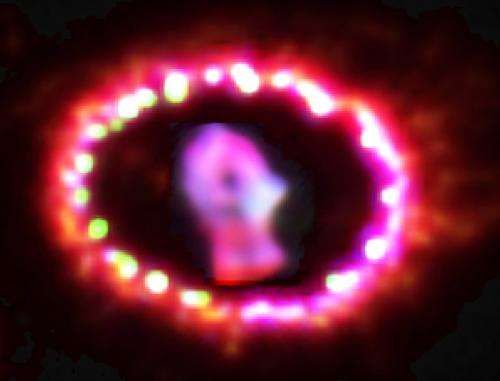X-ray illumination of supernova ejecta

(PhysOrg.com) -- Supernovae are the explosive deaths of massive stars, cataclysms that disburse into space the chemical elements produced by nuclear reactions inside the progenitor stars. Understanding chemical enrichment is reason enough to make supernovae objects of intense study. Astronomers have another reason too: supernovae are probes of the early universe because they are so bright they can be seen at very large distances.
A typical supernova dims very quickly. Its luminosity is powered by the radioactive decay of elements, like isotopes of nickel, that are produced in the explosion, and it shines brightly only for weeks or months, typically leaving behind a pulsar and ejected remnant material.
After a few decades, though, the shock from the explosion will slam into a shell of material that had been blown off by the star before it died, prompting the region to glow brightly again. At least, this is what astronomers think happens. But supernovae occur so rarely in our galaxy that the recurrence process has never been directly observed, while supernovae detected in other galaxies are usually too far away to be able to measure the interaction shock. Since supernovae are so important, astronomers want to be able to measure all aspects of their behaviors; moreover details of the shock can disclose key features of the progenitor star and its demise.
The latest issue of Nature has an article reporting the first direct observation of the transition in a supernova to the shocked interaction between the ejecta of the star and its surrounding medium. CfA astronomers Peter Challis and Bob Kirshner joined with a large team of colleagues to report on a supernova that went off in 1987 in the Large Magellanic Cloud, only about 160,000 light-years away. The Hubble Space Telescope has observed a clumpy shell of material around the star being lit up by the incident shock, and remnant material ejected in the explosion shining brightly again.
The scientists had been watching the remnant dim since 1987 and then slowly brighten again over the past few years. It is now brighter than it has been in decades. Although there are several possibilities (radiation from the pulsar, or radioactive decay from other elements), the team argues that the most likely mechanism is the impact of the shock front onto the shell, thereby producing X-rays that heat the ejected material. Indeed, X-rays are seen by the Chandra X-ray Observatory. If correct, future observations will see the X-ray flux vary in ways that should reveal even more about the original star and its demise.
Provided by Harvard-Smithsonian Center for Astrophysics





















